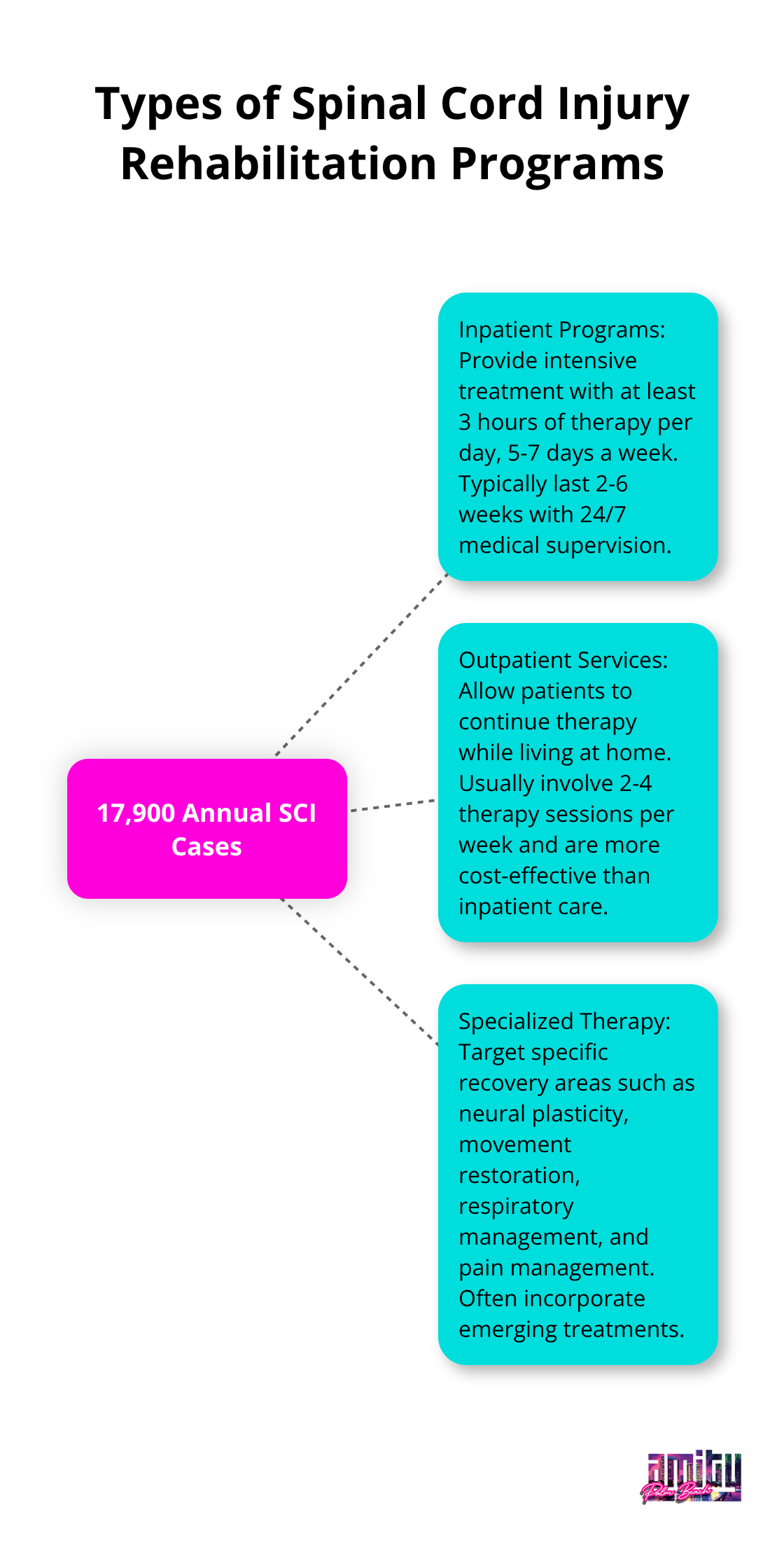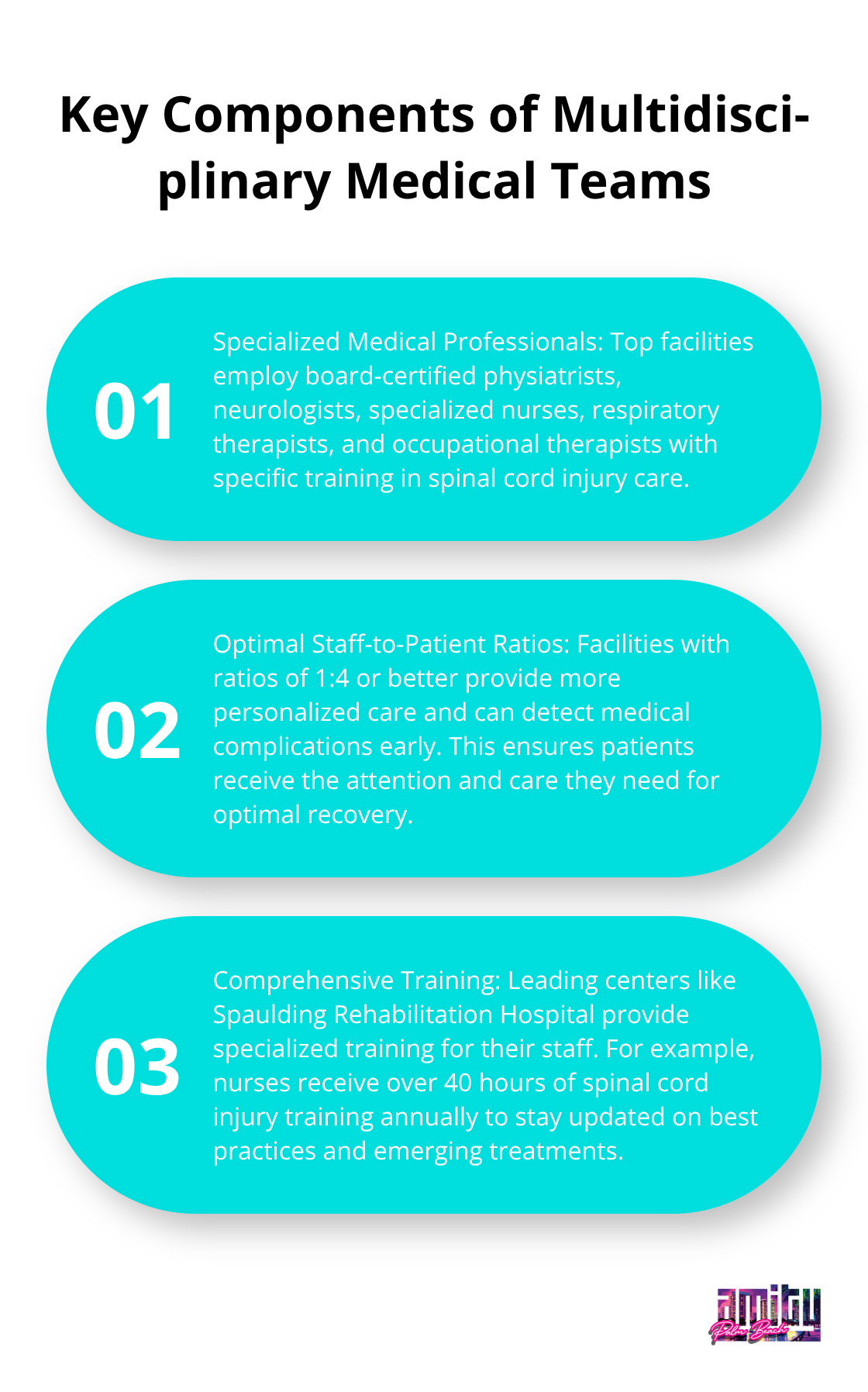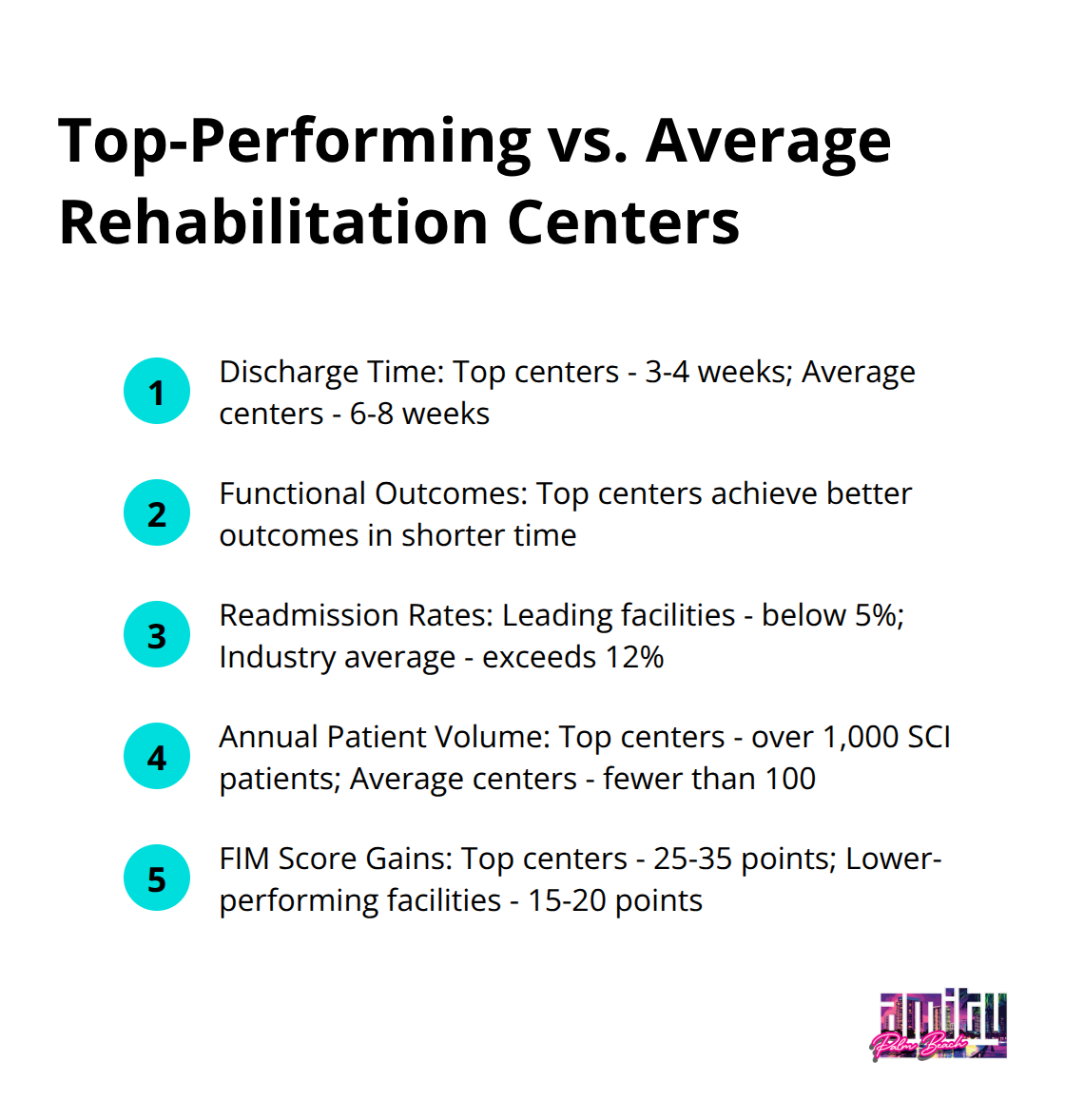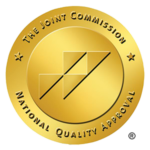Choosing the right rehabilitation center after a spinal cord injury can make the difference between limited recovery and regaining independence. The best spinal cord injury rehab centers combine advanced medical technology with comprehensive support services.
We at Amity Palm Beach understand that every patient’s journey is unique. This guide will help you identify the key features that separate exceptional facilities from average ones.

Types of Spinal Cord Injury Rehabilitation Programs
Inpatient Rehabilitation Programs Deliver Intensive Recovery
Inpatient rehabilitation programs provide the most intensive treatment option for spinal cord injury patients. Medicare standards require therapy for at least 3 hours per day, 5-7 days per week. These programs typically last 2-6 weeks and focus on occupational therapy, physical therapy, and speech therapy when needed.
Patients at top facilities like Shirley Ryan AbilityLab receive 24/7 medical supervision from specialized staff who understand the complex medical complications that can arise after spinal cord injuries. The National Spinal Cord Injury Statistical Center reports that approximately 17,900 new cases occur annually in the United States, making intensive inpatient care a critical first step for many patients.
Inpatient programs work best for patients with recent injuries who need comprehensive medical management alongside rehabilitation services.
Outpatient Services Support Long-Term Recovery Goals
Outpatient rehabilitation services allow patients to continue therapy while they live at home. These programs typically involve 2-4 therapy sessions per week and cost significantly less than inpatient care while they provide specialized treatments like activity-based therapy that focuses on regaining mobility and function.
Facilities such as TIRR Memorial Hermann and Kessler Institute for Rehabilitation offer comprehensive outpatient programs that include access to advanced technologies like exoskeletons and neurostimulation equipment. Outpatient care works particularly well for patients with incomplete injuries who retain some sensation and movement below their injury level.
Research shows that patients who transition from inpatient to structured outpatient programs maintain better long-term functional outcomes compared to those who discontinue formal rehabilitation services.
Specialized Therapy Programs Target Specific Recovery Areas
Specialized therapy programs address unique aspects of spinal cord injury recovery that general rehabilitation cannot adequately cover. Activity-based therapy centers focus specifically on neural plasticity and movement restoration, while some facilities offer specialized programs for respiratory management, bowel and bladder training, and pain management.
Veterans with spinal cord injuries can access specialized resources through VA medical centers that understand military-related injury patterns. These targeted programs often incorporate emerging treatments like riluzole therapy, which has shown improved global outcomes in patients with severe traumatic spinal cord injury, though insurance coverage varies significantly.
Orthopedic rehabilitation programs typically require referrals from primary rehabilitation teams. The success of any rehabilitation program depends heavily on the quality of the medical team and technology available at each facility.
Key Features of Top Spinal Cord Injury Rehab Centers
Multidisciplinary Medical Teams Drive Recovery Success
The quality of medical professionals at a spinal cord injury rehabilitation center directly determines patient outcomes. Top-ranked facilities like Shirley Ryan AbilityLab employ board-certified physiatrists, neurologists, and specialized nurses who understand the complex medical complications that arise after spinal cord injuries. These teams must include respiratory therapists, since patients with cervical injuries often require ventilator management, and occupational therapists with specific training in adaptive equipment and home modifications.
Staff-to-patient ratios matter significantly in spinal cord injury rehabilitation. Facilities with ratios of 1:4 or better provide more personalized care and catch medical complications early. Spaulding Rehabilitation Hospital maintains specialized units where nurses receive 40+ hours of spinal cord injury training annually. The medical team should include psychologists who specialize in adjustment disorders, since depression affects patients with new spinal cord injuries according to the National Spinal Cord Injury Statistical Center.

Advanced Equipment and Technology Accelerate Functional Recovery
Advanced rehabilitation technology separates exceptional centers from standard facilities. Functional electrical stimulation systems, robotic gait training devices like Lokomat, and standing frames are now standard equipment at top-tier centers. TIRR Memorial Hermann utilizes exoskeleton technology that allows paralyzed patients to walk during therapy sessions, which improves cardiovascular health and bone density.
Neurostimulation equipment represents the cutting edge of spinal cord injury treatment. Facilities that offer spinal cord stimulation therapy report improved outcomes in patients with incomplete injuries. The technology costs exceed $100,000 per unit, which explains why only specialized centers invest in these systems. Virtual reality systems for pain management and cognitive rehabilitation are becoming standard at leading facilities, with Craig Hospital reporting 25% better pain control outcomes when VR therapy supplements traditional treatments.
Comprehensive Support Services Address Total Recovery Needs
Medical excellence alone cannot address the complex challenges patients face after spinal cord injuries. Top rehabilitation centers provide case management services that coordinate insurance approvals, equipment procurement, and home modifications before discharge. Kessler Institute for Rehabilitation assigns dedicated case managers who work with patients for up to six months post-discharge to address complications and prevent readmissions.
Family education programs are non-negotiable at exceptional facilities. Caregivers must learn bowel and bladder management, skin care protocols, and emergency procedures. MossRehab requires family members to complete 20 hours of training before patient discharge. Financial counselors help families navigate the lifetime cost of spinal cord injury care. Peer mentorship programs connect new patients with individuals who have similar injuries and have achieved successful community integration.
These comprehensive support systems form the foundation that allows patients to transition successfully from hospital care to independent living. Top centers recognize that no two recoveries are identical, and they create individualized rehabilitation programs that adapt as patients progress, which makes the selection process for rehabilitation centers even more important.
How to Choose the Right Spinal Cord Injury Rehab Center
Distance From Home Impacts Recovery Success Rates
Geographic proximity to family and support systems directly affects rehabilitation outcomes. However, patients who travel to specialized centers often achieve superior results.
Shirley Ryan AbilityLab in Chicago treats over 1,200 spinal cord injury patients annually, while smaller regional hospitals may see fewer than 50 cases. The expertise difference is substantial. Patients should prioritize specialized experience over convenience when the injury is severe or recent.
Transportation logistics become critical for family visits during 4-8 week inpatient stays. Centers like Craig Hospital in Colorado provide family housing discounts, while TIRR Memorial Hermann offers shuttle services from nearby airports. Weather conditions can complicate access to rehabilitation centers, particularly for patients who require medical transport.
Insurance Networks Determine Your Actual Treatment Options
Insurance coverage varies dramatically between rehabilitation hospitals, even among top-ranked facilities. Medicare covers inpatient rehabilitation when patients require at least 3 hours of therapy daily, but many private insurers impose stricter criteria. Kessler Institute accepts most major insurance plans, while specialized facilities like Craig Hospital have limited network participation.
Out-of-network costs for spinal cord injury rehabilitation average $150,000-$300,000 for initial inpatient treatment (according to recent industry data). Pre-authorization requirements can delay admission by 5-10 days, which affects recovery potential. Facilities should provide insurance verification within 24 hours of inquiry.
Some centers like Spaulding Rehabilitation Hospital employ dedicated insurance specialists who maximize coverage approvals. Patients must verify coverage for specific therapies like robotic gait training or neurostimulation, since these advanced treatments often require separate authorizations.
Treatment Volume and Outcome Data Reveal True Quality
Annual patient volume directly correlates with rehabilitation expertise and outcomes. Shirley Ryan AbilityLab treats more spinal cord injury patients than most regional hospitals see in five years. Centers that treat fewer than 100 spinal cord injury patients annually lack the specialized experience necessary for optimal outcomes.
Functional Independence Measure scores provide objective outcome comparisons between facilities. Top centers report average FIM gains of 25-35 points during inpatient stays, while lower-performing facilities average 15-20 points. Length of stay statistics reveal efficiency and quality.
Exceptional facilities discharge patients in 3-4 weeks with better functional outcomes than average centers that require 6-8 weeks. Readmission rates within 30 days indicate quality of discharge planning and medical management. Leading facilities maintain readmission rates below 5%, while industry averages exceed 12%. Facilities should provide specific outcome data for patients with similar injury levels and demographics.

Final Thoughts
Treatment volume, specialized medical teams, and advanced technology separate the best spinal cord injury rehab centers from average facilities. Centers that treat over 1,000 spinal cord injury patients annually possess the expertise necessary for optimal results. Comprehensive care extends beyond medical treatment to include family education, case management, and long-term support services.
The most successful rehabilitation programs address physical recovery alongside psychological adjustment and community reintegration. Insurance coverage verification and outcome data analysis help families make informed decisions during this critical period. Recovery from spinal cord injury demands specialized expertise that only dedicated rehabilitation centers can provide.
The journey ahead presents challenges, but facilities with proven outcomes and comprehensive support systems maximize the potential for independence and quality of life. We at Amity Palm Beach understand that healing requires addressing both physical and emotional needs (which affects long-term recovery success). Our evidence-based treatment approach combines medical excellence with personalized care to support complete recovery.




